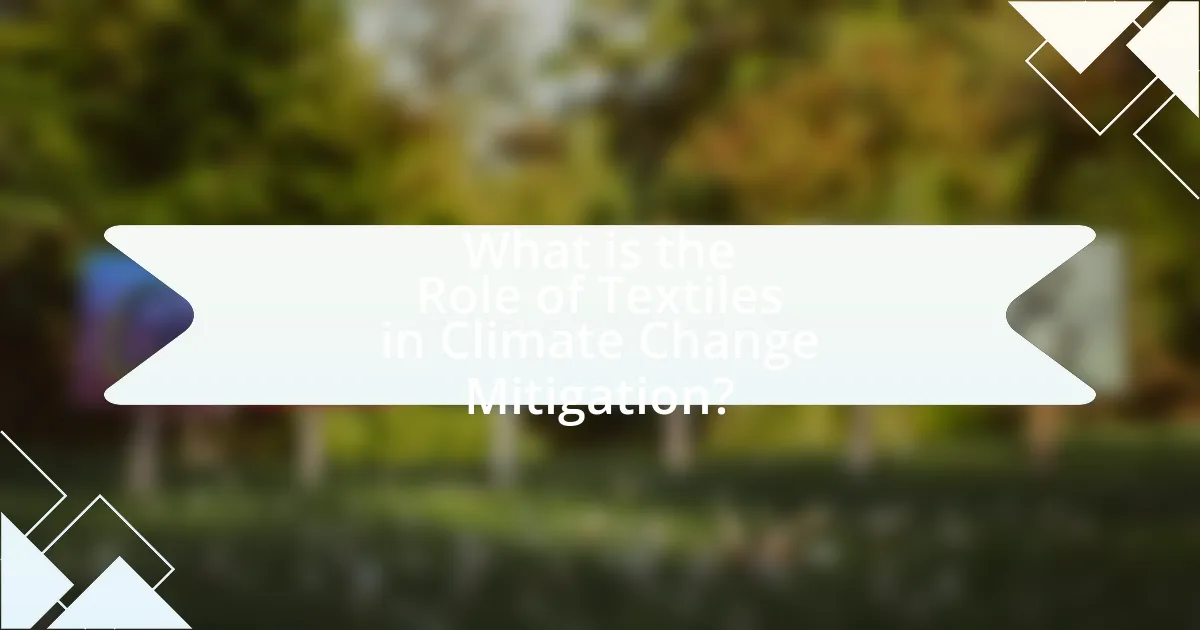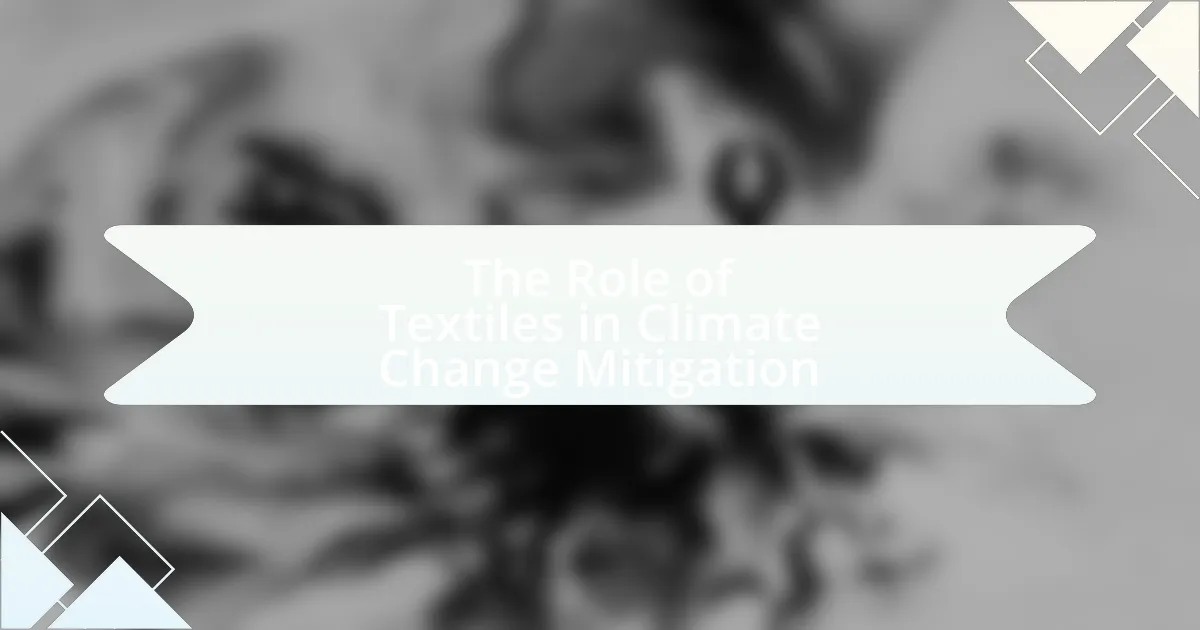The article focuses on the significant role of textiles in climate change mitigation, highlighting that the textile industry accounts for approximately 10% of global greenhouse gas emissions. It discusses sustainable practices such as the use of eco-friendly materials, energy-efficient production methods, and circular economy principles that can reduce emissions. Key processes in textile production, including fiber cultivation and dyeing, are examined for their environmental impact, while innovations in materials and technology are presented as solutions for sustainability. The article also addresses consumer behavior, regulatory influences, and best practices for supporting sustainable textiles, emphasizing the collective responsibility of manufacturers and consumers in combating climate change.

What is the Role of Textiles in Climate Change Mitigation?
Textiles play a crucial role in climate change mitigation by reducing greenhouse gas emissions through sustainable production practices and promoting circular economy principles. The textile industry is responsible for approximately 10% of global carbon emissions, but adopting eco-friendly materials, such as organic cotton and recycled polyester, can significantly lower this impact. Additionally, implementing practices like water conservation, energy efficiency, and waste reduction in textile manufacturing can further decrease emissions. For instance, the use of recycled fibers can reduce energy consumption by up to 60% compared to virgin materials. By transitioning to sustainable practices, the textile sector can contribute to global efforts in combating climate change effectively.
How do textiles contribute to climate change mitigation efforts?
Textiles contribute to climate change mitigation efforts by promoting sustainable practices such as the use of organic materials, recycling, and energy-efficient production methods. Sustainable textiles, made from organic cotton or recycled fibers, reduce greenhouse gas emissions compared to conventional textiles, which often rely on synthetic materials and harmful chemicals. For instance, the Global Fashion Agenda reports that the fashion industry could reduce its carbon emissions by 30% by adopting circular economy principles, which include recycling and reusing textile products. Additionally, energy-efficient production processes, such as those utilizing renewable energy sources, further decrease the carbon footprint associated with textile manufacturing.
What are the key processes in textile production that impact the environment?
The key processes in textile production that impact the environment include fiber cultivation, dyeing, finishing, and waste management. Fiber cultivation, particularly for cotton, often involves extensive water use and pesticide application, leading to soil degradation and water scarcity. Dyeing processes frequently utilize toxic chemicals and large amounts of water, contributing to water pollution. Finishing treatments can release volatile organic compounds (VOCs) into the atmosphere, affecting air quality. Additionally, waste management practices in textile production, such as the disposal of off-cuts and defective items, can lead to significant landfill contributions, exacerbating environmental issues. These processes collectively contribute to the textile industry’s carbon footprint and environmental degradation.
How can sustainable textile practices reduce carbon emissions?
Sustainable textile practices can significantly reduce carbon emissions by utilizing eco-friendly materials, optimizing production processes, and promoting circular economy principles. For instance, organic cotton and recycled polyester have a lower carbon footprint compared to conventional materials, with organic cotton reducing emissions by up to 46% due to less energy-intensive farming methods. Additionally, sustainable practices such as water-efficient dyeing techniques and energy-efficient machinery further minimize greenhouse gas emissions during production. Implementing circular economy strategies, like recycling and upcycling textiles, can also decrease the need for new raw materials, thus reducing emissions associated with extraction and processing. These practices collectively contribute to a more sustainable textile industry, directly impacting climate change mitigation efforts.
Why is the textile industry significant in the context of climate change?
The textile industry is significant in the context of climate change because it is one of the largest contributors to global greenhouse gas emissions, accounting for approximately 10% of total emissions. This impact arises from various stages of production, including raw material extraction, manufacturing processes, and transportation. For instance, the production of cotton alone requires substantial water and energy, leading to increased carbon footprints. Additionally, the industry generates significant waste, with an estimated 92 million tons of textile waste produced annually, further exacerbating environmental degradation. Therefore, addressing the textile industry’s practices is crucial for effective climate change mitigation.
What percentage of global emissions is attributed to the textile industry?
The textile industry is responsible for approximately 10% of global greenhouse gas emissions. This figure is supported by research from the United Nations Environment Programme, which highlights the significant environmental impact of textile production and consumption. The emissions stem from various stages, including raw material extraction, manufacturing, and transportation, underscoring the industry’s substantial contribution to climate change.
How does consumer behavior influence textile-related emissions?
Consumer behavior significantly influences textile-related emissions through purchasing decisions, usage patterns, and disposal practices. When consumers prioritize fast fashion, they contribute to increased production demands, leading to higher emissions from manufacturing processes. For instance, the production of a single cotton t-shirt can generate approximately 2.1 kg of CO2 emissions, highlighting the environmental impact of consumer choices. Additionally, consumers who frequently wash and discard garments contribute to emissions associated with water usage and waste management. Research indicates that extending the lifespan of clothing by just nine months can reduce carbon, water, and waste footprints by 20-30%. Thus, consumer behavior directly correlates with the level of emissions generated in the textile industry.
What innovations are being developed in textiles for climate change mitigation?
Innovations in textiles for climate change mitigation include the development of bio-based fibers, recycled materials, and smart textiles that enhance energy efficiency. Bio-based fibers, such as those derived from organic cotton or hemp, reduce reliance on petroleum-based products, thereby lowering carbon emissions. Recycled materials, like polyester made from post-consumer plastic bottles, significantly decrease waste and energy consumption during production. Smart textiles, which can regulate temperature or harness solar energy, contribute to energy savings and reduce the overall environmental impact of clothing. These advancements are supported by research indicating that the textile industry accounts for approximately 10% of global carbon emissions, highlighting the importance of these innovations in addressing climate change.
What are the latest sustainable materials being used in textiles?
The latest sustainable materials being used in textiles include organic cotton, Tencel (lyocell), recycled polyester, and hemp. Organic cotton is cultivated without synthetic pesticides or fertilizers, reducing environmental impact. Tencel, made from sustainably sourced wood pulp, is biodegradable and produced in a closed-loop process that recycles water and solvents. Recycled polyester, derived from post-consumer plastic bottles, diverts waste from landfills and reduces reliance on virgin petroleum-based materials. Hemp is a fast-growing crop that requires minimal water and pesticides, making it an eco-friendly alternative. These materials contribute to reducing the carbon footprint of the textile industry and promote sustainable practices.
How do technological advancements improve textile sustainability?
Technological advancements improve textile sustainability by enabling more efficient production processes, reducing waste, and promoting the use of eco-friendly materials. Innovations such as digital printing and automated cutting minimize fabric waste, while advancements in recycling technologies allow for the recovery and reuse of textile fibers. For instance, the development of closed-loop recycling systems can reclaim up to 95% of materials from discarded textiles, significantly lowering the environmental impact. Additionally, the use of bio-based and biodegradable materials, facilitated by new manufacturing techniques, reduces reliance on petroleum-based fibers, further enhancing sustainability in the textile industry.
How can the textile industry transition to more sustainable practices?
The textile industry can transition to more sustainable practices by adopting circular economy principles, utilizing eco-friendly materials, and implementing energy-efficient production processes. Circular economy principles involve designing products for longevity, repairability, and recyclability, which reduces waste and resource consumption. For instance, the Global Fashion Agenda’s 2021 report highlights that transitioning to a circular model could reduce greenhouse gas emissions by 44% by 2030. Additionally, using organic cotton, recycled polyester, and other sustainable materials can significantly lower the environmental impact of textile production. According to the Textile Exchange’s 2021 report, the use of recycled fibers can reduce water consumption by up to 90% compared to virgin materials. Finally, energy-efficient production processes, such as adopting renewable energy sources and optimizing water usage, can further decrease the carbon footprint of textile manufacturing.
What are the challenges faced by the textile industry in mitigating climate change?
The textile industry faces significant challenges in mitigating climate change, primarily due to its high carbon emissions, water consumption, and reliance on non-renewable resources. For instance, the industry is responsible for approximately 10% of global carbon emissions, largely from energy-intensive processes like dyeing and finishing. Additionally, the production of textiles consumes around 93 billion cubic meters of water annually, contributing to water scarcity in many regions. The industry’s dependence on synthetic fibers, derived from fossil fuels, further exacerbates its environmental impact. These factors create a complex landscape for the textile industry as it seeks to adopt sustainable practices and reduce its ecological footprint.
How can companies overcome barriers to adopting sustainable practices?
Companies can overcome barriers to adopting sustainable practices by integrating sustainability into their core business strategies and fostering a culture of innovation. This approach encourages collaboration across departments, enabling the identification and implementation of sustainable solutions. For instance, a study by the World Economic Forum highlights that companies that prioritize sustainability can enhance their competitive advantage and improve operational efficiency. Additionally, investing in employee training and stakeholder engagement can facilitate the transition to sustainable practices, as informed employees are more likely to contribute to sustainability goals.
What role do regulations play in promoting sustainable textiles?
Regulations play a crucial role in promoting sustainable textiles by establishing standards that manufacturers must meet to minimize environmental impact. These regulations often include guidelines on resource usage, waste management, and chemical safety, which compel companies to adopt eco-friendly practices. For instance, the European Union’s REACH regulation restricts harmful substances in textiles, encouraging manufacturers to seek safer alternatives. Additionally, regulations can incentivize innovation in sustainable materials and production processes, as seen in the Global Organic Textile Standard, which certifies organic fibers and promotes sustainable farming practices. By enforcing compliance, regulations drive the textile industry towards sustainability, ultimately contributing to climate change mitigation efforts.
What are the best practices for consumers to support sustainable textiles?
Consumers can support sustainable textiles by choosing to buy from brands that prioritize eco-friendly materials and ethical production practices. This includes selecting textiles made from organic cotton, hemp, or recycled fibers, which significantly reduce environmental impact compared to conventional materials. Additionally, consumers should look for certifications such as Global Organic Textile Standard (GOTS) or OEKO-TEX, which ensure that textiles meet strict environmental and social criteria.
Furthermore, consumers can extend the life of their garments through proper care, repair, and upcycling, which minimizes waste and reduces the demand for new textiles. According to the Ellen MacArthur Foundation, extending the life of clothing by just nine months can reduce carbon, water, and waste footprints by around 20-30%. Lastly, participating in clothing swaps or purchasing second-hand items can further support sustainability by reducing the overall consumption of new textiles.
How can consumers identify sustainable textile products?
Consumers can identify sustainable textile products by looking for certifications such as Global Organic Textile Standard (GOTS), OEKO-TEX Standard 100, and Fair Trade. These certifications ensure that the textiles meet specific environmental and social criteria, indicating responsible production practices. For instance, GOTS requires a minimum of 70% organic fibers and prohibits harmful chemicals, while OEKO-TEX ensures that textiles are free from harmful substances. Additionally, consumers should consider the materials used; organic cotton, hemp, and Tencel are often more sustainable options compared to conventional fibers.
What actions can consumers take to reduce their textile footprint?
Consumers can reduce their textile footprint by opting for sustainable clothing choices, such as purchasing from brands that prioritize eco-friendly materials and ethical production practices. Research indicates that the fashion industry is responsible for about 10% of global carbon emissions, highlighting the impact of consumer choices on climate change. By choosing second-hand clothing, consumers can extend the lifecycle of garments, thereby reducing waste and resource consumption. Additionally, washing clothes in cold water and air-drying can significantly decrease energy usage, further minimizing their textile footprint.

Leave a Reply